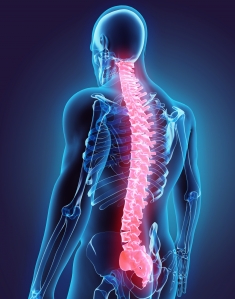BME Professors are Advancing Exciting Spinal Cord Research

Ten years ago, Rutgers football star Eric LeGrand suffered a spinal cord injury (SCI) during a game at MetLife Stadium. Despite a poor prognosis, in the years since he has exceeded expectations for his recovery and rehabilitation – and has become a noted motivational speaker, entrepreneur, sports analyst, philanthropist, and author. He has also been a source of inspiration for Rutgers’ Department of Biomedical Engineering (BME) faculty and students who are exploring innovative ways to treat and repair SCIs.
An estimated 294,000 people in the United States live with SCI that primarily result from vehicle crashes, falls, gunshot wounds, and sport or recreation activities, according to the National Spinal Cord Injury Statistical Center. Permanent effects of SCI include the loss of strength, sensation, and function – or paralysis – below the site of an injury.
“SCI is a devastating and life-altering form of trauma. For almost two decades, Rutgers BME faculty have been working to understand SCI and develop technology and approaches to help those who have suffered from it. Largely through research grants supported by the New Jersey Commission for Spinal Cord Research (NJCSCR), we see great promise in engineered solutions to: regenerate the spinal cord through gene therapy; provide alternative function through brain-computer interfaces; and accelerate the healing of chronic wounds,” says BME chair and professor David Shreiber.
Developing a Gene Therapy to Help SCI Patents Regain Motor Control
“SCI affects every aspect of a patient’s life,” says associate professor of biomedical engineering Li Cai. “It exerts a significant economic, emotional, and physical toll on patients and their caregivers.”
While no treatments currently exist that can reverse the paralysis resulting from an SCI, in 2019 Cai’s lab made an exciting discovery of a potential gene therapy that may help thousands of SCI patients regain motor control.
“We have developed a novel experimental gene therapy that promotes the regeneration of neurons in the injured spinal cord, resulting in dramatic functional recovery in an animal model of SCI,” he explains. “This has the potential to become a treatment for SCI that enhances spinal cord regeneration, attenuates scarring, and reestablishes the spinal cord circuitry – all of which are essential for functional recovery.”
Cai’s discovery has been recognized by a venture capital firm, which has invested in a startup company he has established to further develop the gene therapy. “The startup company has optioned this technology from Rutgers and partnered with both Rutgers and contract research organizations to conduct additional pre-clinical validation studies. It is also sponsoring a feasibility testing at Rutgers, which will benefit from the potential commercial success of this technology,” notes Cai.
New Treatments to Alleviate Pressure Sores
Much of biomedical engineering professor François Berthiaume’s research focuses on alleviating the problem of pressure – or bed – sores in spinal cord injured patients, which are common secondary complications of SCI.”
Berthiaume has been invited to submit a proposal for an “expansion award” from the Department of Defense, to continue funded research to develop new compounds that will increase blood vessel formation and blood flow when applied topically to pressure sores – and speed up and improve the healing of these wounds.
“This expansion proposal includes working with individuals who live with SCI. Rutgers’ alumnus Eric LeGrand is one of them.”
Improving Eric LeGrand’s Quality of Life
BME senior design groups led by distinguished professor Noshir A. Langrana have worked with Eric LeGrand to outfit a drone that LeGrand can control using his phone. The goal is to functionalize the drone to complete tasks such as retrieving fallen objects. Langrana and BME seniors have also 3D-printed customized stylus holders to attach to Eric's wheelchair to allow him to easily pick up and place back his stylus, which he controls with his mouth. This simple design has had a profound impact on Eric's quality of life.
NJCSCR Research Funds Faculty SCI Projects
The New Jersey Commission on Spinal Cord Research has awarded multiple grants to support BME faculty projects. These include grants to:
- Shreiber, who together with mechanical and aerospace engineering professor Assimina A. Pelegri, is developing computational models to understand how axons in spinal cord white matter are damaged during SCI. These multi-scale models predict how stress and strain experienced in the white matter are translated down to individual axons at the microscale. A better understanding of how axons are damaged can lead to improved means and measures of preventing that damage.
- Biomedical engineering professor Jeffrey D. Zahn, whose project aims to create technology for brain-computer interfaces, is working with Shreiber, cell biology and neuroscience professor David J. Margolis, and Board of Governors professor of chemistry Joachim Kohn on developing flexible microelectrodes that can record signals from neurons in the brain. These signals can be decoded and used to control things like a computer mouse or wheelchair to allow greater independence for paralyzed patients. The small size and flexibility of the probes are critical for evading the brain’s immune system and improving the longevity of the probes and could have the potential to acquire neural signals over longer periods of time – which could translate into greater clinical use for spinal cord injured patients.
- Paul and Mary Monroe chair and distinguished professor Martin L. Yarmush, who has received two grants. The first supports his continued development of a method to treat SCI using genetically modified encapsulated mesenchymal stromal cells that can secrete enzymes that degrade proteoglycans to reduce glial scarring and suppress host inflammation. His second grant funds research towards developing a new technique for tracking electrodermal skin responses in patients with SCI in order to detect pressure ulcers before clinical manifestations.
- Berthiaume, along with distinguished professor Melitta Schachner from Rutgers’ W.M. Keck Center for Collaborative Neuroscience, and Suneel Kumar, an assistant research professor in Berthiaume’s lab, have received a two-year, $200,000 award from the NJCSCR to develop new protein therapeutics to promote functional repair of a damaged spinal cord.

